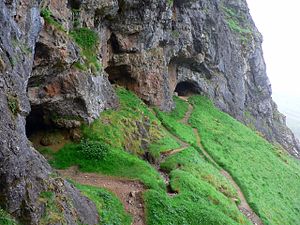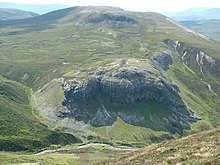Bone Caves of Inchnadamph: Difference between revisions
Created page with "{{Infobox cave |name=Bone Caves |county=Sutherland |picture=Scotland Inchnadamph Bone Caves.jpg |picture caption=The Bone Caves |os grid ref=NC267170 |latitude=58.108028 |long..." |
No edit summary |
||
| Line 24: | Line 24: | ||
The skeleton of a bear thought to be 11,000 years old or more was removed from the caves in 2008. The bones had originally been found by cavers in 1995 deep within the Uamh an Claonaite system and the original supposition was that this was the remains of a Cave Bear. The bones were passed on to the National Museums Scotland, to determine the age and species. It is presumed the animal died whilst hibernating and that its body was later washed further into the underground network.<ref>Restan, Sue (29 July 2008) "Bear skeleton finally taken from cave in Sutherland". Aberdeen. ''The Press and Journal''.</ref> | The skeleton of a bear thought to be 11,000 years old or more was removed from the caves in 2008. The bones had originally been found by cavers in 1995 deep within the Uamh an Claonaite system and the original supposition was that this was the remains of a Cave Bear. The bones were passed on to the National Museums Scotland, to determine the age and species. It is presumed the animal died whilst hibernating and that its body was later washed further into the underground network.<ref>Restan, Sue (29 July 2008) "Bear skeleton finally taken from cave in Sutherland". Aberdeen. ''The Press and Journal''.</ref> | ||
[[File:Bone Caves Crag from Beinn nan Cnaimhseag - geograph.org.uk - 1022792.jpg|right|thumb|220px|Creag nan Uamh on Beinn an Fhuarain]] | |||
==Outside links== | ==Outside links== | ||
{{commons|Bone Caves}} | {{commons|Bone Caves}} | ||
Latest revision as of 22:18, 30 September 2016
| Bone Caves | |
| Sutherland | |
|---|---|
 The Bone Caves | |
| NC267170 | |
| Co-ordinates: | 58°6’29"N, 4°56’29"W |
The Bone Caves are a group of four limestone caves in the Assynt district of Sutherland which have revealed a remarkable collection of Ice Age bones, which have given the caves their name.
The caves are in a cliff known as 'Creag nan Uamh', which means "Crag of the Caves", above the valley of the Allt nan Uamh, on the north slope of Beinn an Fhuarain. The caves can be reached by a three to four mile walk from Inchnadamph, which stands at the south-eastern tip of Loch Assynt.
The caves are natural limestone caves, formed over many ages by the effect of water trickling through the cracks and fissures in the limestone and slowly dissolving the rock. Certainly the caves were here before the last Ice Age.
The caves here are only shallow and are the remains of a larger cave system that extended over a wide area, known as the Uamh an Claonaite system. Over thousands of years, the valley has gradually deepened, cutting away part of the cave system, and leaving the caves we see today high and dry on the valley side.
Bones
Within the Bone Caves of Inchnadamph have been found the bones of many species which lived in these parts in ancient times, many of them now extinct in Britain.
The bones include those of the Eurasian lynx, brown bear, Arctic fox and reindeer (dated to as long ago as 47,000 years ago). In 1995, explorers found the bones of a polar bear: this is the only evidence of polar bears so far found in Britain. There were also human skeletons dated to the 3rd millennium BC.[1][2][3]
The skeleton of a bear thought to be 11,000 years old or more was removed from the caves in 2008. The bones had originally been found by cavers in 1995 deep within the Uamh an Claonaite system and the original supposition was that this was the remains of a Cave Bear. The bones were passed on to the National Museums Scotland, to determine the age and species. It is presumed the animal died whilst hibernating and that its body was later washed further into the underground network.[4]

Outside links
| ("Wikimedia Commons" has material about Bone Caves of Inchnadamph) |
Refernces
- ↑ McKenzie, Steven (10 December 2007) New tests on rare polar bear find"
- ↑ Murray, W H (1977) The Companion Guide to the West Highlands of Scotland. (Collins). Murray states the skeletons were dated to 6000 BC.
- ↑ "Inchnadamph Bone Caves " SNH Retrieved 29 July 2008. This source and McKenzie (2007) mentions dates of 4515 and 4720 BP for the human remains.
- ↑ Restan, Sue (29 July 2008) "Bear skeleton finally taken from cave in Sutherland". Aberdeen. The Press and Journal.
